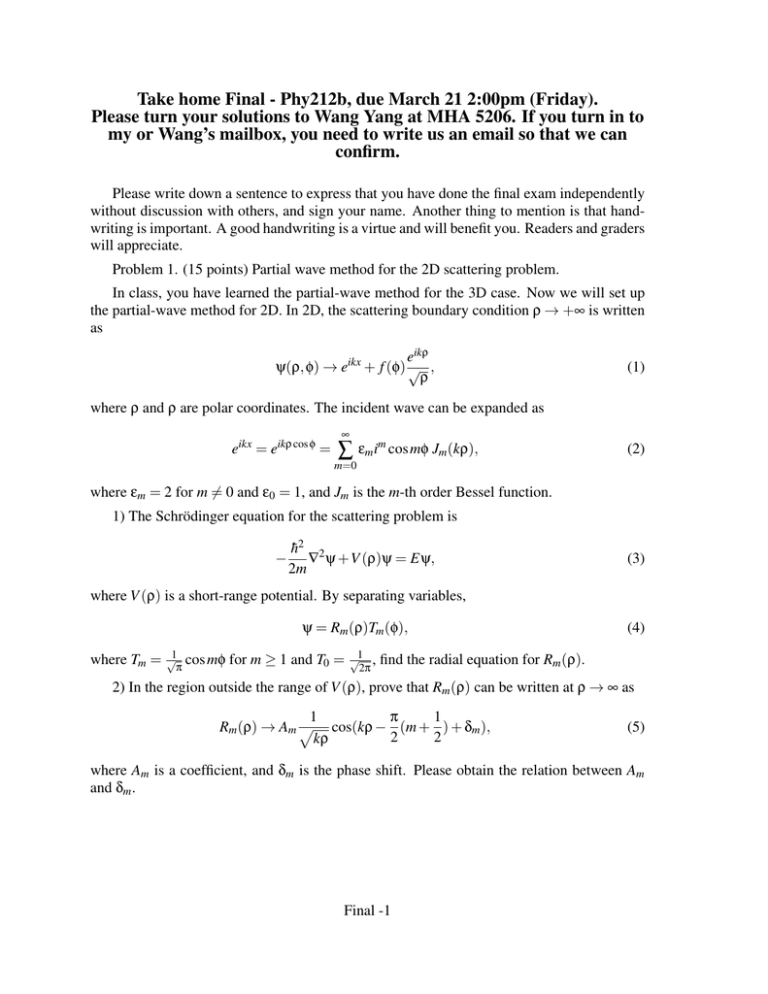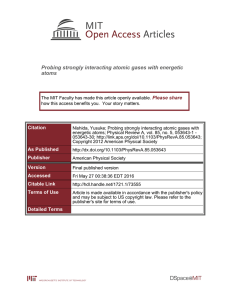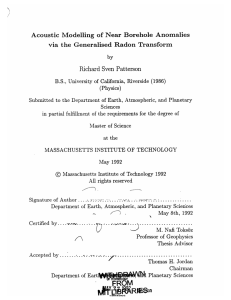Take home Final - Phy212b, due March 21 2:00pm (Friday).
advertisement

Take home Final - Phy212b, due March 21 2:00pm (Friday). Please turn your solutions to Wang Yang at MHA 5206. If you turn in to my or Wang’s mailbox, you need to write us an email so that we can confirm. Please write down a sentence to express that you have done the final exam independently without discussion with others, and sign your name. Another thing to mention is that handwriting is important. A good handwriting is a virtue and will benefit you. Readers and graders will appreciate. Problem 1. (15 points) Partial wave method for the 2D scattering problem. In class, you have learned the partial-wave method for the 3D case. Now we will set up the partial-wave method for 2D. In 2D, the scattering boundary condition ρ → +∞ is written as ikx ψ(ρ, φ) → e eikρ + f (φ) √ , ρ (1) where ρ and ρ are polar coordinates. The incident wave can be expanded as eikx = eikρ cos φ = ∞ ∑ εmim cos mφ Jm(kρ), (2) m=0 where εm = 2 for m 6= 0 and ε0 = 1, and Jm is the m-th order Bessel function. 1) The Schrödinger equation for the scattering problem is − h̄2 2 ∇ ψ +V (ρ)ψ = Eψ, 2m (3) where V (ρ) is a short-range potential. By separating variables, ψ = Rm (ρ)Tm (φ), where Tm = √1 cos mφ π for m ≥ 1 and T0 = √1 , 2π (4) find the radial equation for Rm (ρ). 2) In the region outside the range of V (ρ), prove that Rm (ρ) can be written at ρ → ∞ as 1 π 1 Rm (ρ) → Am p cos(kρ − (m + ) + δm ), 2 2 kρ (5) where Am is a coefficient, and δm is the phase shift. Please obtain the relation between Am and δm . Final -1 Hint: You need to use the asymptotic forms of the m-th order Bessel functions at ρ → ∞: s π 1 2 Jm (kρ) → cos(kρ − (m + )) πkρ 2 2 s 2 π 1 Nm (kρ) → sin(kρ − (m + )). (6) πkρ 2 2 3) By comparing Eq. 5 with the scattering boundary condition, please derive the expression of f (φ). 4) We can define the “total scattering length” as Z 2π λ= λ(φ)dφ, (7) 0 where λ(φ) = | f (φ)|2 . Derive an expression of λ in terms of k and phase shifts δm for all m ≥ 0. Final -2 Problem 2 (15 points) 3D scattering problem. We consider the scattering problem of a particle with mass m in the center force field in 3D V (r) = α , r2 (8) where α > 0. 1) Use the 3D partial wave method to solve δl with l a non-negative integer. l represents the partial wave channel. Hint: The radial equation can be solved exactly by using the spherical Bessel function jν (kr) of order ν, where ν is not necessarily an integer number l. jν (kr) satisfies the equation 2 d ν(ν + 1) d2 2 j + j + (k − ) jν = 0, ν ν dr2 r dr r2 (9) and its asymptotic behavior at r → ∞ is jν (kr) → νπ 1 sin(kr − ). kr 2 (10) You need to decide the appropriate value of ν to use. 2) Under the condition that mα 18 , find the approximate formulae for δl , scattering h̄2 amplitude f (θ), and the differential cross section σ(θ). 3) Use Born approximation to calculate f (θ) and σ(θ) again, and compare with results in 2). Hint: You may need to use the formula 1 ∑ Pl (cos θ) = sin θ . l 2 Final -3 (11) Problem 3. (18 points) Berry phase in momentum space. In class, we discussed Berry phase in parameter space. Now we take the parameter space as momentum space, and study the Berry connection as the eigenstates vary with momentum. This problem is closely related to the anomalous Hall effects. Consider a spin-orbit coupled Hamiltonian in a 2D free space as h̄2 (∇2x + ∇2y ) − λ(−ih̄~∇ ×~σ) · êz − ∆σz , H =− 2m (12) where ~σ are Pauli matrices, and ∆ is the effective Zeeman field that originates from ferromagnetic ordering, λ is the spin-orbit coupling constant, êz is the unit vector along the z-direction. 1) In the momentum representation, show that H(~k) maps to a two-level problem as h̄2 k2 H(~k) = −~n(~k) ·~σ. 2m (13) Please determine the form of the 3-vector ~n as a vector function of ~k. Please note that ~n is NOT normalized to 1. Solve the spectra of H(~k) which have two branches. The upper and lower branches are denoted as ε± (~k), respectively. Sketch the spectra of ε± (~k) as functions of (kx , ky ) for both ∆ > 0 and ∆ = 0. 2) Calculate the eigenvector ψ− (~k) for the lower branch states of H(~k). 3) Assume ∆ > 0, and define the Berry connection for the lower branch as varying ~k as ~A(kx , ky ) = −ihψ− (~k)|∇~ |ψ− (~k)i. k (14) Calculate ~A(kx , ky ). 4) Define the Berry curvature as Ω(kx , ky ) = ∂kx Aky − ∂ky Akx . (15) Calculate Ω(kx , ky ). 5) What is the value of the total Berry flux over the entire 2D (kx , ky ) plane Z +∞ −∞ Z +∞ dkx −∞ dky Ω(kx , ky )? (16) 6) Sketch the distribution of Ω(kx , ky ) in the (kx , ky ) space at ∆ > 0. Where does Ω get the maximal value? Now let’s gradually decrease ∆, how does this distribution evolves? If we finally set ∆ = 0, what happens? Final -4








